The story of South African currency
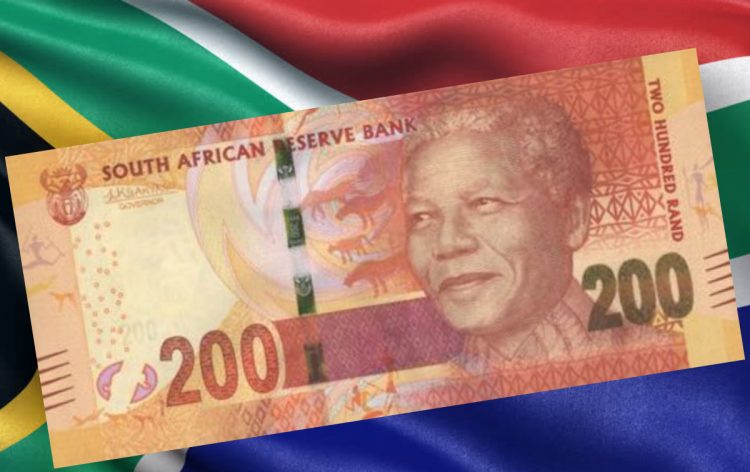
Understanding the currencies is a very important part of Forex trading. Of course, you do not need to know the history of all currencies out there, even if you are trading with it. However, the South African Rand has a very interesting history and many South Africans are not aware of it. In this article, let’s take a closer look at how and why ZAR was created, what is the story of South African banknotes and the history of the USD/ZAR currency rate.
The story of South African money does not begin with the Rand obviously. The country has a very long and rich history of money and otherwise. However, let’s not go too far back and concentrate more on the currency as we know it.
Before Rand was created
The Dutch Guilder
The history of money in South Africa started when coins were first introduced in the region. The first European settlers landed on the shores of South Africa in 1652 and brought coins with them. Amongst the settlers, there was a Dutch explorer, Jan van Riebeck. He established a trading station, which was created on behalf of the Dutch East India Company. This trading station later become known as Cape Town. The money used in the newly established trading station was the Dutch guilder, the official currency of the Netherlands. Since there was a steam of traders and sailors passing through the Cape, they were bringing currencies of their homeland, therefore Cape Town had several currencies they were trading with such as Spanish Real, English Guinea, Portuguese Joannes, and even Japanese Koban. However, the Dutch Guilders were most commonly used.
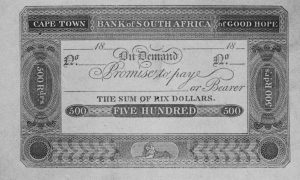 The Rixdollar – The first paper money
The Rixdollar – The first paper money
The first paper money in Cape Town was brought in 1782, when the Dutch Governor, Van Plettenberg was not able to procure a sufficient quantity of coinage from the Netherlands for the requirements of the Cape settlement. The paper money was issued in Rixdollar and stiver denominations, which were the currency of the Cape at that time. Interestingly, the first notes were handwritten as there was no printing press. The notes featured a government fiscal hand stamp that was indicating the note’s value and the date of its issue.
The British Pound Sterling
In 1795 the Dutch East India Company went bankrupt and the power of the Dutch in Cape crumbled. Instead of the Dutch, Great Britain declared Cape Town a Britsh colony and took control over the region in 1806. They, of course, introduced their own money. However, it was still possible to use other currencies for trading due to the shortfall in change until 1826. At that time, sterling coinage became the sole legal tender and various foreign currencies were not allowed to circulate.
The first South African coin – the Burgers Pond
The history of South African money continued in 1830, when over 12,000 Boers, people of Dutch descent escaped from the British colony. They established South Africa and several decades later, in 1874, the fourth president of SA, Thomas Francois Burger, decided to create the first South African coin. 300 ounces of gold were sent to London and the coins with the portrait of the president were sent back. The first SA coin – the “Burgers Pond” was created.
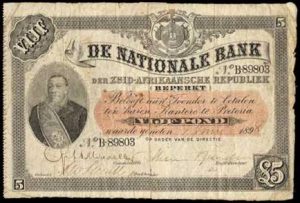 The South African Pound
The South African Pound
When gold was discovered in the region, the government of South Africa built a mint in Pretoria, they started mining the gold and issuing its own currency in coins in 1892 until 1902. The coins had the portrait of the president Paul Kruger and were based on the British Sterling.
In 1902 the production of the mint and of the South African coins came to an end as the second Anglo-Boer war started. Pretoria was invaded by British people and the Boer government fled, taking the gold with them.
Following the war, the Union of South Africa was created in 1910. The union was under British rule and united the Cape and Natal colonies and two Boer republics. The production of the SA coins started again in 1923 in Pretoria’s Royal Mint. The coins had the same value and were identical to the coins that were used in Britain. The next important year for the South African money’s history was 1931 when South Africa got independence from Britain.
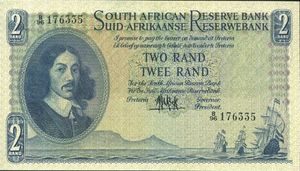 Creation of the Rand and South African Republic
Creation of the Rand and South African Republic
After South Africa was granted independence from Britain, it still continued issuing and using the coins that were based on the British coin system. It continued until 1961 when South Africa became a republic. With this, the history of South African Rand started. The government issued the first currency of the newly established republic and named it Rand. The name Rand comes from the name – Witwatersrand – which is a range of hills that have the source of 40 percent of the world’s gold. On 14th of February 1961, The Rand replaced the South African pound on legal tender. The first banknotes were R1, R5, R10, and R20, they were signed by the Governor Dr. R. Rissik and were active till 1967.
South African Banknote information
From 1961 till today’s date, the banknotes changed over seven times, due to the changes of the governors of the reserve banks, as the banknotes should have had the signature of the current governor. Here are some interesting South African Banknote information and facts.
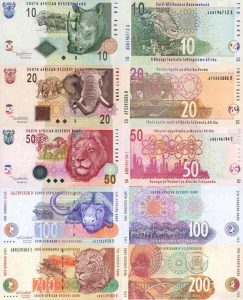
- The first banknotes that were issued, were printed in two versions, one was with Afrikaans writing and the other with English. Today, the language on the front selection of all banknotes is English.
- Currently, South African Rands are available in banknotes of R10, R20, R50, R100, and R200 and are signed by the current governor Lesetja Kganyago.
- The history of South African Rand is represented in its ISO code – ZAR, as it comes from the Dutch words “Zuid-Afrikaanse Rand”
- The main colors of ZAR banknotes are as follows green (R10), brown (R20), red (R50), Blue (R100), Yellow-orange (R200)
- All of the new banknotes have the image of former president Nelson Mandela, when they were first introduced, sometimes were referred to as “Randela”
- The back of the banknotes has had the Big Five since 1990 – five animals that represent the wildlife of South Africa. These animals are placed on the banknotes respectively: Rhinoceros (R10), Elephant (R20), Lion (R50), Buffalo (R100) and Leopard (R200)
All of the banknotes have the same height of 70 mm, but the length is different, the highest the value of the banknote is, the more is its length. The lengths of R10, R20, R50, R100, and R200 is 128 mm, 134 mm, 140 mm, 146 mm and 152 mm respectively.
How SA banknotes are secured
- All of the banknotes that are in the circulation around the world, need to match the international standards of quality and security. The South African banknotes fulfill the criteria and have several security features on them.
- The watermark of the South African rand banknote presents the shadow image of the former president of South Africa Nelson Mandela. It has a hidden denomination of the banknote, that is clearer than the image of the president
- On the back of all banknotes, there are unique serial numbers printed, which consist of letters and numbers. While the numbers on the left side are vertical, the serial number on the right top increases in height from left to right.
- There is a security thread woven into the banknote paper and it is only 4 mm. If you observe closely you will see the denomination number, the words “RAND” and SARB” printed on it and the three-dimensional image of the Coat of Arms of South Africa.
History of the currency rate
When the Rand was first created in 1961 until 1982 it had the highest value against the US dollar. However, over time the exchange rate was changing, therefore it is interesting to see the USD ZAR exchange rate history.
Decrease in value
Over 20 years, South Africa was enjoying a strong currency, however, the currency lost its footing on the global market due to the system of Apartheid in South Africa. The South African government decided to delink the Rand from the dollar. In 1974 the SA government introduced a policy of independently managed floating. At that period of time, the Rand was trading at 87 cents to the dollar. However, the new system brought changes and the first major fall was recorded in the history of Rand.
There were several important points in history. In 1980, there was a big boom in the value of gold. It strengthened the value of the Rand significantly, however, it had the same effect when the value of gold declined. After three years the Rand exchange rate system was abolished by the apartheid government. As a result, international banks refused to renew credit lines for SA and the foreign-exchange market was temporarily closed. After these changes in 1985, the rand was at its worst against USD, at R2.23 but the worst was yet to come.
After the Apartheid government
In 1994 the democratic elections took place in South Africa. Certain things, such as South Africa’s international relations normalized at a certain degree. However, it was not enough for the recovery of the Rand and the exchange rate of it against the US dollar remained in a downward trend for a long time.
The political uncertainty was very high in post-apartheid South Africa, the Rand/USD exchange rate was highly impacted by the social, political and economic events in the country and on the international level. At that time, in 1994 the Rand was R3.55 versus the dollar on average.
In 1999, new president Thabo Mbeki was elected and the Rand’s value was set on R6.11. The situation got even worse as the value of the Rand against the US reached its worst point in USD/ZAR exchange history. When the attacks on the world trade center took place in the US in September 2001 the value of ZAR was R13.84.
After 2002 the USD/ZAR exchange rate was fluctuating a lot since many of the local events were affecting it, such as energy issues, increased debt, and socio-political events. Local and international crises were constantly weakening the value. The major events were the Eskom’s power crisis in 2007, the European sovereign debt crisis in the same year, the euro-crisis itself, the global recession in 2008 and the continued uncertainty of the euro-zone crisis.
The history of Rand continues
After all of these events and situations that were affecting the value, the Rand became very weak against the US dollar. However, the history of South African Rand continues. South Africa economy is growing slowly but steadily and the economic outlook of the country is more promising. The current president of the country is striving for foreign investments that can help to strengthen the Rand against the USD and hopefully the process of it will start soon.














Comments (0 comment(s))